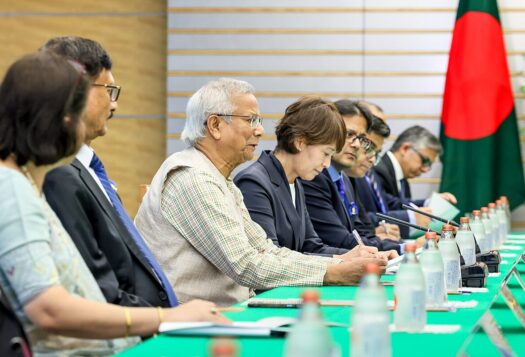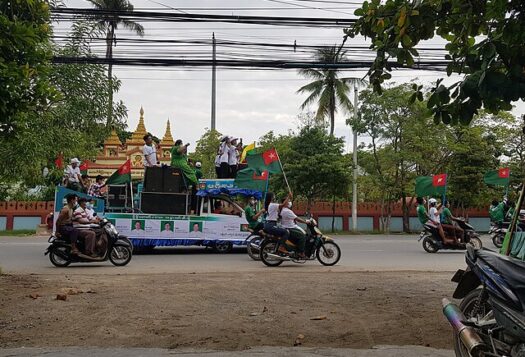
Pakistan is a fragile democracy, and the treatment of Balochistan by the Pakistani military and civilian establishment exposes its democratic facade. Federal and provincial governments have failed to address separatist elements in Balochistan, improve human rights conditions, prevent democratic backsliding, and implement effective economic policies. Widespread discontent in Balochistan against Pakistan’s establishment presents a mounting problem for the state’s stability.
Predominantly occupied by terrorism, Pakistani media does not comprehensively report on the multitude of factors behind Balochistan’s instability. By solely focusing on terrorism, the Pakistani state takes a security-centric approach that inaccurately presents military might as the solution to a multidimensional issue. Instead, the state should focus on reconciliation and socio-economic reform.
The Baloch Long March Calls for Change
On December 22, 2023, Dr. Mahrang Baloch, a prominent human rights activist from Balochistan, started marching from Turbat, in southwestern Balochistan, to the National Press Club in Islamabad with nearly 400 members of the Baloch community, including women and children. Her protest called the “Baloch Long March,” garnered attention for its stand against the rampant number of abductions, enforced disappearances, and extrajudicial killings in Balochistan. In the latest march in a long history of resistance, the protesters allege that Pakistani security forces killed Balaach Mola Bakhsh and three other young Baloch men, who were allegedly involved in “terrorist activities,” without evidence or due process. According to the government-initiated Commission of Inquiry on Enforced Disappearances, the Pakistani state has conducted a total of 10,078 enforced disappearances since 2011 with 2,752 from Balochistan alone. Amnesty International has called these enforced disappearances by Pakistan’s state security services a “kill and dump policy.”
Since the military has failed to eliminate nationalist sentiment by force, a two-pronged approach that commits to reconciliation and reform is the only feasible alternative.
The militarization of Balochistan, as a response to the growth of violent separatist and ethnonationalist organizations such as the Balochistan Liberation Army (BLA), contributes to a long list of grievances held by Baloch. Increased military checkpoints, often to protect Chinese infrastructure and extractive projects built under the China-Pakistan Economic Corridor (CPEC), create a militarized environment that fosters resentment and creates the local perception that Balochistan’s resources do not benefit Baloch. Pakistani security forces’ brutal tactics to control and repress fractured the Baloch nationalist movement and resulted in a provincial government that lacks legitimacy and control over the province, making serious negotiations and effective solutions in coordination with the civilian government nearly impossible.
The pattern of Balochistan’s socio-economic oppression is another condition that fuels organized crime and recruitment into separatist groups. The UN Development Program’s Multidimensional Poverty Index indicates that Balochistan’s poverty level is double the national level at 71.2 percent. According to official estimates, Balochistan has high dropout rates, wide gender disparities in education and health, widespread food insecurity, and insufficient infrastructure and private sector economy. The Baloch people’s increasing resentment and resistance in Gwadar, resulting from their economic marginalization, have prompted the government to adopt a more aggressive approach to achieve its economic ambitions. This perpetuates a cycle of animosity that further fuels Balochistan’s instability.
Achievable Pathways Toward Reconciliation and Reforms
The Baloch Long March presents a significant political opportunity for the federal government to begin socio-economic reform and reconciliation with the Baloch people, addressing the root causes of separatist violence and instability. Since the military has failed to eliminate nationalist sentiment by force, a two-pronged approach that commits to reconciliation and reform is the only feasible alternative.
Reconciliation
A promising reconciliation process would center the Baloch people by prosecuting officers responsible for enforced disappearances, appointing credible local leadership to run the province and represent the peoples’ interests at the federal level, and initiating backchannel negotiations with insurgent groups.
A crucial aspect of a reconciliation policy is accountability for the perpetrators of extrajudicial crimes and compensation for the families of victims. The Supreme Court of Pakistan should hold the military and intelligence agencies accountable for their human rights abuses in Balochistan by prosecuting officers who have committed unconstitutional acts. Under previous governments, enforced disappearances continued alongside reconciliation efforts with Baloch nationalists, creating an environment in which disaffected Balochs were not willing to enter the political mainstream. In October 2009, Benazir Bhutto’s Reconciliatory Committee on Balochistan presented a roadmap to tackle the security and socio-economic grievances of the province. However, the plan never moved forward because the Baloch nationalist movement feared the government would use it to distract from the further physical elimination of Baloch nationalists.
A necessary aspect of this political process is increased autonomy for the provincial government of Balochistan, as guaranteed by the 18th Constitutional Amendment. If the provincial government is seen as an extension of the leadership in Islamabad, it will lack the mandate and the legitimacy to initiate any reforms. The government must work with trusted local figures to enact lasting change.

Previous attempts at reconciliation have been half-hearted because Baloch representatives did not have the backing of their people. In 2021, Prime Minister Imran Khan appointed Shahzain Bugti as the Special Assistant to the Prime Minister on Reconciliation and Harmony in Balochistan, whose lack of influence, tribal support, credibility as a broker, and desire to conduct meaningful negotiations killed talks. Influential Baloch leaders and activists such as Dr. Mahrang Baloch, Sammi Deen Baloch, or current Baloch leaders such as Chief Minister Sarfaraz Bugti who understand the grievances of the Baloch people can bridge the distrust between the government and nationalists to facilitate a productive reconciliation process. In addition, the Pakistani establishment should also involve parties outside of the government and student groups in the reconciliation process, such as Baloch Student Organization-Azad (BSO-Azad), BSO-Mengal, and BSO-Pajjar, to demonstrate the state’s desire for compromise with disenfranchised youth.
Finally, while Pakistan’s leadership will never heed the demand for a separate Balochistan, it can start backchannel conversations with insurgent groups and give them viable avenues to make political demands through non-violent means. Mainstream Baloch nationalist politicians do not believe Pakistan’s political establishment has any authority to initiate reconciliation talks with insurgents, saying that true reconciliation needs to be conducted directly by the military. After years of counterinsurgency operations that only deepened Baloch resentment, the Pakistani military should consider increased provincial autonomy and an active role for separatist groups in a political solution as an acceptable compromise to stabilize Balochistan. While compromises might cause separatist groups to become stronger in the interim, it is a risk that the government and the military have to take. To minimize this risk, negotiators can include a condition of surrender for the militant groups to participate in political negotiations.
In sum, reconciliation must include accountability for the criminal actions of military and intelligence officers, representative governance, and credible talks with nationalist parties, separatist groups, and student organizations.
Reforms
Addressing the education, healthcare, and employment gaps while reallocating resources back to the Baloch people will build trust between the current stakeholders and the federal government, rendering reconciliation and peace-building efforts credible.
To alleviate the education crisis, the federal government should partner with the provincial government to enhance funding for public schools. According to official data, about 800,000 children do not attend school. The massive floods in 2022 destroyed 5500 schools, of which only 50 were repaired. To make the policy more effective than previous initiatives, the provincial government should set up committees that monitor the implementation of these funds and ensure accountability.
To address the grievances of the Baloch people effectively and stop the cycle of animosity and violence, the Pakistani state must shift from a security-centered approach to one that prioritizes socio-economic development and local political legitimacy.
Similarly, the provincial government must build more basic healthcare units and recruit healthcare personnel to address the province’s dire needs for preventative medicine, childcare, and vaccination. The current doctor-to-patient ratio in Balochistan is 1:1000, and the nurse-to-patient ratio is 1:50. The federal and provincial governments can improve access to healthcare facilities in remote areas of Balochistan by partnering with private NGOs and companies focusing on socio-economic development. For example, the Aga Khan Development Network (AKDN) has done extensive work in Gilgit Baltistan to alleviate poverty and healthcare needs. A strategic investment of the provincial government’s available resources would be partnerships with agencies similar to AKDN.
Finally, to boost the province’s local economy, the federal government should give Balochistan its share in the ownership and management of federally-owned oil and gas companies. Infrastructure, shipping, and resource extraction projects in Balochistan, such as those under CPEC, should give employment preference to the local Baloch community. CPEC projects almost exclusively employ Chinese laborers who replace local labor in construction projects, which became a driving source of disaffection in the province. Providing Baloch employment would also be a viable way to provide technical skill training; by funding technical training centers, the provincial government can upskill workers, enhance productivity, and increase the province’s economic output.
Conclusion
The Pakistani establishment must include the Baloch people in the province’s development. Repressive measures will continue to erode the trust between the state and its people in the long term, stymieing any prospects of security, stability, and true economic progress. Reconciliation will not be successful if the federal government refuses to address the socio-economic issues of the province. To address the grievances of the Baloch people effectively and stop the cycle of animosity and violence, the Pakistani state must shift from a security-centered approach to one that prioritizes socio-economic development and local political legitimacy.
Also Read: Pakistan’s May 9 Protests: Army Crackdown and a State of Exception
***
Click here to read this article Urdu.
Image 1: Landscape of Balochistan via Michael Foley on Flickr
Image 2: Protests against killing of Karima Baloch via Picryl


